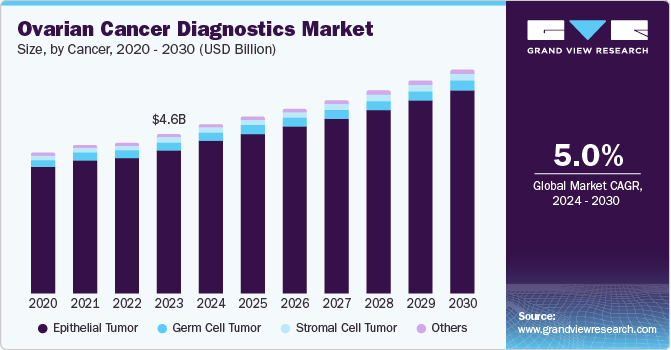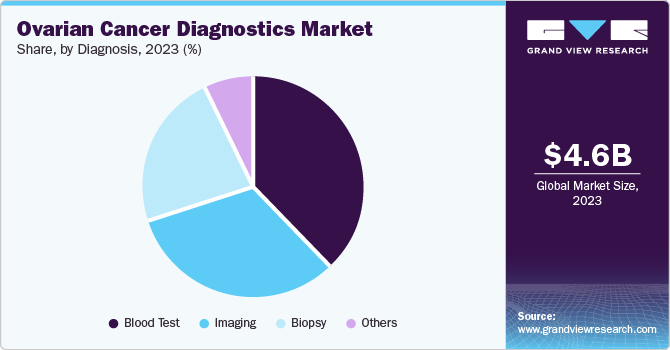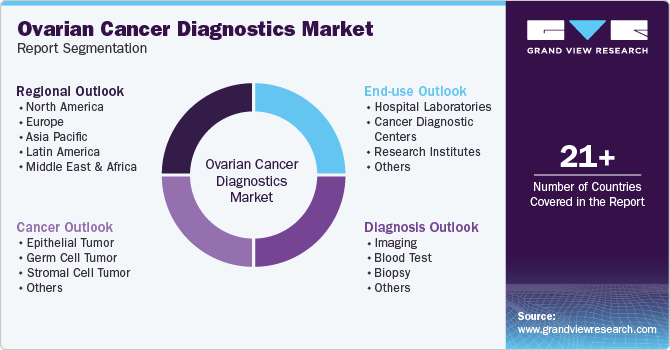
Ovarian Cancer Diagnostics Market Size, Share, & Trends Analysis Report By Cancer (Epithelial Tumor, Germ Cell Tumor, Stromal Cell Tumor), By Diagnosis (Imaging, Blood Test, Biopsy), By End-use, By Region, And Segment Forecasts, 2024 - 2030
- Report ID: GVR-3-68038-421-5
- Number of Report Pages: 100
- Format: PDF, Horizon Databook
- Historical Range: 2020 - 2023
- Forecast Period: 2024 - 2030
- Industry: Healthcare
Ovarian Cancer Diagnostics Market Trends
The global ovarian cancer diagnostics market size was valued at USD 4.60 billion in 2023 and is expected to grow at a CAGR of 5.0% from 2024 to 2030. Increasing prevalence of ovarian cancer and increased emphasis on early diagnosis and treatment are the key factors expected to drive market growth. As of 2023, ovarian cancer has the highest death rate among all gynecological cancers, underscoring the critical need for advanced diagnostic tools. The American Cancer Society estimates that more than 19,000 patients will be diagnosed with ovarian cancer in the U.S. in 2024. This statistic is fueling the growth of the ovarian cancer diagnostics market, as healthcare providers and researchers strive to improve early detection and treatment outcomes.

Innovations in diagnostic technologies, such as next-generation sequencing (NGS), liquid biopsy, and biomarker discovery, are significantly enhancing the accuracy and efficiency of ovarian cancer diagnostics, driving market growth. NGS allows for comprehensive genomic profiling, enabling the identification of genetic mutations and alterations associated with ovarian cancer, which aids in precise diagnosis and personalized treatment planning. Liquid biopsy, a minimally invasive technique, detects circulating tumor DNA (ctDNA) and other biomarkers in blood, providing real-time insights into tumor dynamics and enabling early detection, monitoring, and assessment of treatment response. These technological advancements reduce the time and cost associated with traditional diagnostic methods, making ovarian cancer diagnostics more accessible and effective.
Governments worldwide are significantly boosting funding for cancer research and the development of diagnostic tools, which is propelling advancements and the adoption of ovarian cancer diagnostics. This financial support is enabling researchers to explore and develop innovative diagnostic technologies, such as advanced imaging techniques, next-generation sequencing (NGS), and liquid biopsies, which are crucial for the early detection and accurate diagnosis of ovarian cancer. In 2022, the National Cancer Institute (NCI) allocated USD 6.8 billion, including USD 216 million from the Cures Act, reflecting an increase of 5.7%, or USD 366.6 million, from 2021. This significant increase in funding is crucial for advancing cancer research and developing innovative diagnostic tools, which are essential for improving early detection and treatment outcomes for various types of cancer, including ovarian cancer.
Cancer Insights
Epithelial tumor held the largest market revenue share in 2023. According to National Library of Medicine, epithelial ovarian tumors, the most common type of ovarian cancer, account for about 95% of all ovarian cancer cases. This high incidence rate significantly drives the demand for effective diagnostic tools tailored specifically to this cancer type. Given the substantial proportion of ovarian cancer patients affected by epithelial tumors, there is a critical need for accurate and efficient diagnostic methods to identify and characterize these tumors at an early stage.
Technological innovations in imaging techniques, molecular diagnostics, and genetic profiling are significantly enhancing the accuracy and early detection of stromal cell tumors within the global ovarian cancer diagnostics market. Advanced emerging technologies, such as magnetic resonance imaging (MRI) and ultrasound, provide detailed images that helps in identifying and characterizing stromal cell tumors with greater precision than traditional methods is driving the growth of stromal cell tumor segment.
Diagnosis Insights
The imaging segment held the largest market revenue share in 2023. Advances in imaging technologies, including MRI, CT, and ultrasound, have revolutionized the early detection of ovarian cancer, significantly enhancing their adoption in diagnostic protocols. MRI offers detailed images of soft tissues in the pelvis, allowing for precise localization and characterization of ovarian tumors.

Innovations in biopsy technologies, such as ultrasound-guided biopsies, fine-needle aspiration (FNA), and core needle biopsy (CNB), are improving accuracy and reducing invasiveness, thereby increasing their adoption in ovarian cancer diagnostics.
End-use Insights
The hospital laboratories segment held the highest market revenue share in 2023. Hospitals often collaborate with diagnostic companies, research institutions, and pharmaceutical companies to enhance diagnostic capabilities and develop innovative diagnostic tools for ovarian cancer. These partnerships contribute to the adoption of new diagnostic technologies in hospital settings. In May 2024, the Maharashtra government announced plans to outsource critical healthcare services in state hospitals through collaborations with private entities. This initiative aims to extend advanced healthcare services to remote and underserved areas, thereby improving patients’ access to quality medical care.
The increasing integration of Artificial Intelligence (AI) and Machine Learning (ML) algorithms in ovarian cancer diagnostics is driving advancement in healthcare sector. AI and ML technologies enable cancer diagnostic centers to analyze vast amounts of patient data quickly and accurately, aiding in early detection and precise prognosis. These algorithms detect subtle patterns and anomalies in imaging results, biomarker data, and genetic profiles that may indicate ovarian cancer at its earliest stages, when treatment is most effective.
Regional Insights
North America ovarian cancer diagnostics market held the largest share of 40.4% in 2023. High healthcare expenditure in North America is driving investments towards advanced diagnostic technologies and infrastructure within cancer diagnostic centers. The substantial financial resources available enable healthcare providers and institutions to adopt and integrate cutting-edge diagnostic modalities, such as genetic testing, molecular imaging, and AI-driven analytics, into clinical practice. This timely adoption of new technologies enhances the accuracy, efficiency, and scope of diagnostic capabilities for diseases like ovarian cancer. The financial capability supports the development of state-of-the-art facilities equipped with specialized equipment and skilled healthcare professionals, thereby improving patient access to comprehensive diagnostic services.

U.S. Ovarian Cancer Diagnostics Market Trends
The U.S. ovarian cancer diagnostics market shows advancements in diagnostic technologies are also transforming methods for diagnosis of ovarian cancer in the U.S. Techniques such as MRI and CT scans provide detailed images that help detect ovarian tumors, assess their size and spread more accurately. These imaging methods have improved significantly, offering better resolution and contrast, which enhances their effectiveness in diagnosis and treatment planning. Biomarker tests, such as CA-125 and HE4 measurements in blood samples, are crucial for monitoring cancer progression and treatment response. When combined with advanced imaging, these biomarkers provide a comprehensive approach to diagnosing ovarian cancer across its stages. Genetic testing plays a key role in identifying mutations like BRCA1 and BRCA2, linked to higher ovarian cancer risks. This genetic information not only aids in early detection among high-risk individuals but also guides personalized treatment strategies. Continued advancements in these technologies promise earlier detection, improved outcomes, and potentially reduced mortality rates from ovarian cancer.
Europe Ovarian Cancer Diagnostics Market Trends
Collaboration among advanced diagnostics companies in Europe is important in driving advancements within the Europe ovarian cancer diagnostics market. These collaborations foster the collective expertise and resources of various companies to accelerate the development and adoption of innovative diagnostic technologies. Collaborative efforts involve joint research initiatives, clinical trials, and the establishment of standardized protocols for diagnostic testing. This concerted approach addresses challenges such as regulatory hurdles and reimbursement pathways, which are critical for scaling up advanced diagnostic solutions in clinical practice.
Asia Pacific Ovarian Cancer Diagnostics Market Trends
The integration of digital health platforms and telemedicine services represents a transformative advancement in enhancing access to ovarian cancer diagnostics across remote and underserved regions of the Asia Pacific. Telehealth solutions enable healthcare providers to conduct virtual consultations, remotely monitor patient health data in real-time, and facilitate telepathology services for efficient diagnostic assessments. These technologies overcome geographical barriers, allowing patients in remote areas to receive timely medical consultations and diagnostic evaluations from specialists located in urban centers.
Digital health platforms support seamless data integration and secure transmission of medical records, ensuring comprehensive patient care coordination and continuity. By leveraging telemedicine, healthcare providers can optimize resource allocation, improve diagnostic accuracy, and expedite treatment planning, enhancing healthcare access and outcomes for ovarian cancer patients in diverse and geographically dispersed populations within the Asia Pacific region.
Key Ovarian Cancer Diagnostics Company Insights
Major players are increasingly focusing on strategic initiatives, such as product launches & development, mergers & acquisitions, licensing partnerships, and co-development deals, making this market highly competitive.
- F. Hoffmann-La Roche AG offers biomarker assays, crucial for monitoring ovarian cancer progression and treatment response. Its offerings include innovative molecular imaging technologies and digital pathology solutions, enabling precise tumor characterization and personalized treatment planning.
Key Ovarian Cancer Diagnostics Companies:
The following are the leading companies in the ovarian cancer diagnostics market. These companies collectively hold the largest market share and dictate industry trends.
- F. Hoffmann-La Roche AG
- Johnson & Johnson Services, Inc.
- GlaxoSmithKline Plc
- AstraZeneca Plc
- Siemens Healthcare GmbH
- Abbott
- Thermo Fisher Scientific
- Bio-Rad Laboratories, Inc
- Quest Diagnostics Incorporated
- Illumina, Inc
Recent Developments
-
In February 2023, Uniogen reported that it was developing a test for detecting ovarian cancer. It is a cost-effective diagnostic and fast test to detect difficult-to-diagnose cancer earlier, thereby making it possible to initiate treatment immediately.
Ovarian Cancer Diagnostics Market Report Scope
|
Report Attribute |
Details |
|
Market size value in 2024 |
USD 4.81 billion |
|
Revenue forecast in 2030 |
USD 6.46 billion |
|
Growth Rate |
CAGR of 5.0 % from 2024 to 2030 |
|
Base year for estimation |
2023 |
|
Historical data |
2020 - 2023 |
|
Forecast period |
2024 - 2030 |
|
Quantitative units |
Revenue in USD billion and CAGR from 2024 to 2030 |
|
Report coverage |
Revenue forecast, company ranking, competitive landscape, growth factors, and trends |
|
Segments covered |
Diagnosis, cancer, end-use, region |
|
Regional scope |
North America, Europe, Asia Pacific, Latin America, MEA |
|
Country scope |
U.S., Canada, Mexico Germany, UK, Germany, France, Italy, Spain, Denmark, Sweden, Norway Japan, China , India, Australia, South Korea, Thailand , Brazil, Argentina, South Africa, South Arabia, UAE & Kuwait |
|
Key companies profiled |
F. Hoffmann-La Roche AG, Johnson & Johnson Services Inc., GlaxoSmithKline Plc, AstraZeneca Plc, Siemens Healthcare GmbH, Abbott, Thermo Fisher Scientific, Bio-Rad Laboratories, Inc, Quest Diagnostics Incorporated, Illumina, Inc |
|
Customization scope |
Free report customization (equivalent up to 8 analysts working days) with purchase. Addition or alteration to country, regional & segment scope. |
|
Pricing and purchase options |
Avail customized purchase options to meet your exact research needs. Explore purchase options |
Global Ovarian Cancer Diagnostics Market Report Segmentation
This report forecasts revenue growth at global, regional, and country levels and provides an analysis of the latest industry trends in each of the sub-segments from 2020 to 2030. For this study, Grand View Research has segmented the global ovarian cancer diagnostics market report based on cancer, diagnosis, end-use, and region:

-
Cancer Outlook (Revenue, USD Billion, 2020 - 2030)
-
Epithelial Tumor
-
Germ Cell Tumor
-
Stromal Cell Tumor
-
Others
-
-
Diagnosis Outlook (Revenue, USD Billion, 2020 - 2030)
-
Imaging
-
Ultrasound
-
CT Scan
-
MRI Scan
-
PET Scan
-
Others
-
-
Blood Test
-
CA125
-
HER2
-
BRCA
-
CEA
-
ER & PR
-
KRAS Mutation
-
Others
-
-
Biopsy
-
Others
-
-
End-use Outlook (Revenue, USD Billion, 2020 - 2030)
-
Hospital Laboratories
-
Cancer Diagnostic Centers
-
Research Institutes
-
Others
-
-
Regional Outlook (Revenue, USD Billion, 2020 - 2030)
-
North America
-
U.S.
-
Canada
-
Mexico
-
-
Europe
-
Uk
-
Germany
-
France
-
Italy
-
Spain
-
Denmark
-
Sweden
-
Norway
-
-
Asia Pacific
-
China
-
Japan
-
India
-
Australia
-
South Korea
-
Thailand
-
-
Latin America
-
Brazil
-
Argentina
-
-
Middle East and Africa (MEA)
-
UAE
-
South Arabia
-
South Africa
-
Kuwait
-
-
We are committed towards customer satisfaction, and quality service.
"The quality of research they have done for us has been excellent."




